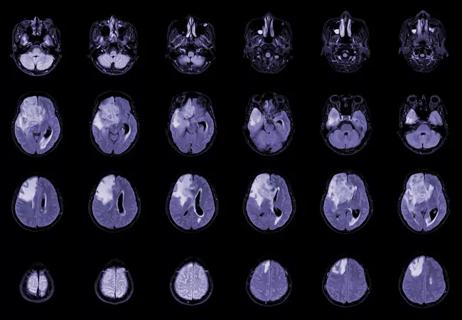Researchers use AI tools to compare clinical events with continuous patient monitoring

A team of Cleveland Clinic investigators is using a smartwatch (Apple Watch) to discern biomarkers and signatures of disease progression and events in patients with glioblastoma. Using artificial intelligence (AI) tools, data from the watch’s various sensors are compared with real-time symptoms and events as logged by the patient into an iPhone app that was developed by the research team.
Advertisement
Cleveland Clinic is a non-profit academic medical center. Advertising on our site helps support our mission. We do not endorse non-Cleveland Clinic products or services. Policy
“We hope to be able to generate signatures that one day can be used to predict events, monitor disease progression and even guide treatment based on easily acquired data,” says Andrew Dhawan, MD, PhD, a neuro-oncologist in Cleveland Clinic’s Rose Ella Burkhardt Brain Tumor and Neuro-Oncology Center and a principal investigator with the project. “We may find that thromboembolism, for example, is usually preceded by heart rate and blood oxygen changes, potentially giving us the ability to bring the patient in for testing and treatment before an event occurs if we detect a worrisome pattern in the smartwatch data.”
“Clinical applications of wearable continuous-monitoring smartwatch devices are starting to be explored,” adds co-principal investigator Rowan Barker-Clarke, PhD, a postdoctoral research scientist at Cleveland Clinic. “Considering that nearly half of Americans wear a smartwatch, it is an enormously untapped resource with great potential.”
Dr. Barker-Clarke, who focuses on digital biomarkers and novel applications of smart devices, recently received a Postdoctoral Fellowship Award from the American Cancer Society for the glioblastoma investigations.
Some clinical uses of wearable devices that already have been developed include detection of falls, seizures and heart arrhythmias; generation of medication reminders to patients from their healthcare provider; and submission of self-reported mood and symptoms to a doctor’s office. A recent study reported that smartwatch data can reflect blood test results.
Advertisement
The new Cleveland Clinic research takes such applications a step further by developing the ability to use continuously monitored data to predict events before they occur and guide management before disease progression is otherwise apparent.
“We chose to focus our initial efforts on glioblastoma because of its rapid progression and high rate of complications, as well as the dearth of effective therapies,” says Dr. Dhawan. “We would like to move the needle in improving management for these patients.”
A preliminary single-arm trial is now ongoing (NCT06129760) to determine patient acceptability of the data collection requirements and to analyze initial data. Cleveland Clinic patients with a diagnosis of glioblastoma (N = 25) wear the smartwatch for six months, with continuous passive collection of raw data (e.g., from the device’s accelerometer, gyroscope and blood oxygen sensor) and processed data (including walking asymmetry, steadiness, calories used, active energy measures and vital signs).
Participants are instructed to record their symptoms and events (e.g., headache, nausea, tremors and seizures) on the study’s mobile app. Data from clinical visits, such as imaging findings and Karnofsky Performance Scale scores, are also entered. Patients receive their regular care; the trial does not include a clinical care protocol.

Data are analyzed with machine learning tools, with the goals of characterizing patient signatures and identifying biomarkers of disease progression.
Publication of results is expected by late 2025.
Advertisement
The researchers expect to use the information gained through their investigations to develop “digital twin” models of patients, a tool useful for guiding individualized patient care and improving prognostic accuracy. They anticipate that they will one day make the system available to others, allowing smartwatch data to be converted automatically into usable clinical information for patients and healthcare providers.
The team is particularly interested in identifying patterns that precede thromboembolism, seizures and tumor progression. This may allow timely prediction of such events and enable swifter treatment.
Improving functional assessment, which is associated with future survival in glioblastoma, is another study goal. Smartwatch data (e.g., walking speed and steadiness, number of daily steps and how frequently activity occurs throughout the day) reflect a patient’s general health status. One or a combination of such variables may prove to approximate the Karnofsky Performance Scale score — a metric routinely used in clinical practice to track glioblastoma disease progression — or turn out to be an even more sensitive indicator of prognosis.
“It’s possible that doctors may one day start relying less on laboratory tests and imaging to monitor glioblastoma progression and more on inexpensive wearable devices of the type that many patients are already using,” says Dr. Barker-Clarke.
Dr. Dhawan anticipates that if results of the current trial are promising, the team will expand the patient population to include additional institutions and patients with other gliomas.
Advertisement
“This is an easily scalable project, given the low cost of the technology and the ability to analyze large amounts of data through our AI models,” Dr. Barker-Clarke explains. “More data will allow us to generate more accurate prediction algorithms for more purposes.”
“Applications for this research go well beyond glioblastoma,” Dr. Dhawan adds. “We’ve had interest from clinicians for applying this technology to other cancers and to movement disorders.”
Advertisement
Advertisement

Advances in genomics, spinal fluid analysis, wearable-based patient monitoring and more

Combining dual inhibition with anti-PD1 therapy yielded >60% rate of complete tumor regression

Cleveland Clinic researchers pursue answers on basic science and clinical fronts

New research from Cleveland Clinic helps explain why these tumors are so refractory to treatment, and suggests new therapeutic avenues

Presurgical planning and careful consideration of pathology are key to achieving benefits

Study demonstrates its role in tumor lethality, raises prospect of therapeutic targets

Focused ultrasound is paired with ALA to utilize sonodynamic therapy to target cancer cells

Can T-cell immunophenotyping help inform treatment decisions?